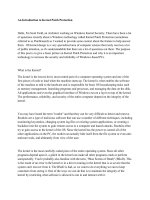Capital investment appraisal (an introduction)
Bạn đang xem bản rút gọn của tài liệu. Xem và tải ngay bản đầy đủ của tài liệu tại đây (193.87 KB, 41 trang )
Session 2
Capital Investment Appraisal
(An Introduction)
CAP1 Finance, Academic Year 2011 / 2012
© Chartered Accountants Ireland
Session 2 Capital Investment Appraisal
• By the end of today’s session(s), you should be able to:
– Understand the context of investment appraisal decisions
– Evaluate capital projects using the ARR, the payback period
method, the discounted payback period, the IRR and the NPV
techniques.
– Discuss the advantages and disadvantages of each method
– Explain research findings in respect of the practical application of
the methods.
Overall aim of three lectures on this topic – to enable trainees to select
appropriate investment methods and to calculate investment returns
for competing projects and to justify a course of action including
consideration of relevant non-financial factors and financing options.
CAP1 Finance, Academic Year 2011 / 2012
© Chartered Accountants Ireland
Competency Wheel
Financial Reporting
Ethics & Professionalism
Strategic Thinking & Problem
Solving
Management Accounting &
Objectivity
Communication
Perceptiveness of own knowledge,
values and limitations
Managing Self & Others:
Leadership
Finance
Audit & Assurance
Tax & Law
Strategy
IT Awareness
Project Management &
Change Awareness
Stakeholder Management
CAP1 Finance, Academic Year 2011 / 2012
© Chartered Accountants Ireland
Mapping
•
This lecture maps specifically to 2.1 on the Competency Statement
Functional
Competencies
Business
Competencies
Explain and demonstrate
the ability to use the
payback, discounted
payback, accounting rate of
return, net present value
and internal rate of return
techniques.
Be able to appraise a
variety of different projects
for communication to
management.
Recommend and justify a
course of action, including
consideration of nonfinancial factors.
Evaluate and communicate
an appropriate course of
action given the entity’s
unique characteristics and
the environment
CAP1 Finance, Academic Year 2011 / 2012
© Chartered Accountants Ireland
Core Professional
Values & Skills
The need to be objective
when evaluating differing
projects.
Difficulties with Project Appraisal
CAP1 Finance, Academic Year 2011 / 2012
© Chartered Accountants Ireland
5
Difficulties facing project appraisal
•
•
•
•
•
•
•
•
Goal congruence
Relevant cash flows
Time value of money
Profit versus cash
Capital rationing
Projects with unequal lives
Risk (next class)
Financing
CAP1 Finance, Academic Year 2011 / 2012
© Chartered Accountants Ireland
6
Goal Congruence
Ultimately the project’s outcome should increase equity holder value.
Decision makers - view the big picture, which may involve rejecting
projects that have short-term returns in favour of projects with higher
overall long-term returns.
Take liquidity into consideration.
CAP1 Finance, Academic Year 2011 / 2012
© Chartered Accountants Ireland
7
Relevant cash flows
Not all cash flows should be brought into the appraisal process –
only relevant cash flows.
Relevant cash flows are incremental cash flows and opportunity
cash flows.
They exclude:
• Sunk costs
• Apportioned costs that were going to be incurred anyway
CAP1 Finance, Academic Year 2011 / 2012
© Chartered Accountants Ireland
8
Cash flows explained
Incremental cash flows are those that will occur only as a
consequence of a project being undertaken.
Opportunity cash flows are cash flows forgone from other
investments, or actions that have been changed, as a result of
the project being implemented.
Cash flows that occur as a result of decisions made in the past,
which cannot be changed are deemed to be sunk cash flows.
CAP1 Finance, Academic Year 2011 / 2012
© Chartered Accountants Ireland
9
The time value of money/cash V profit
In finance CASH IS KING.
Cash is very different to profit.
Management performance is usually assessed using profitability.
However, the pattern of cash is more important for project appraisal
because of the time value of money.
Example (assume you are assessing a 5 year period) – in terms of
profitability €/£1m each year for 5 years is the same as €/£5 million
at the end of year 5.
In finance, the latter option is valued much LOWER – because of the
time value of money
CAP1 Finance, Academic Year 2011 / 2012
© Chartered Accountants Ireland
10
Financing
BRIEF POINTS
• Matching principle – match the life of the project with the
life of the finance
• Self-liquidating – try to ensure that the finance selected
has liquidity commitments that can be serviced from the
project itself
• Cash synchronisation – match the timing of the cash flows
resulting from the investment with the timing of the
repayments on the source of finance.
• Cost of finance – take into account the company’s current
cost of capital
Note: This topic is covered in detail later in the course
CAP1 Finance, Academic Year 2011 / 2012
© Chartered Accountants Ireland
Project appraisal - techniques
Accounting Rate of Return (ARR)
Payback period
Discounted payback period
Internal rate of return (IRR)
Net present value (NPV)
CAP1 Finance, Academic Year 2011 / 2012
© Chartered Accountants Ireland
12
Accounting Rate of Return
CAP1 Finance, Academic Year 2011 / 2012
© Chartered Accountants Ireland
13
ARR
The accounting rate of return estimates the rate of accounting
profit that a project will generate over its entire life.
It compares the average annual profit of a project with the
average cost (book value) of the project.
CAP1 Finance, Academic Year 2011 / 2012
© Chartered Accountants Ireland
14
ARR - calculation
ARR = Average annual profit x 100
Average capital invested
Where the average annual profit is the total profit for the
whole period (after depreciation) divided by the life of the
investment in years; and
The average capital invested is the initial capital cost plus the
expected disposal value divided by two.
CAP1 Finance, Academic Year 2011 / 2012
© Chartered Accountants Ireland
15
ARR – example
Cow Ltd. is considering three projects (each costing €/£240,000).
The following cashflows are predicted:
Friesian
Aberdeen
Cashflows
€/£
€/£
Year 1
160,000
120,000
Year 2
60,000
120,000
Year 3
120,000
40,000
Year 4
140,000
Year 5
20,000
Year 6
10,000
Saler
€/£
238,000
2,000
35,000
REQUIRED
Given that Cow Ltd. has a target average accounting rate of return of 10% per
annum which of the above projects should be accepted, if any? (Assume that the
asset is specialised and cannot be sold at the end of the project).
How would the results be affected were you informed that the asset could be sold
after three years for €/£60,000 and after six years for €/£30,000.
CAP1 Finance, Academic Year 2011 / 2012
© Chartered Accountants Ireland
16
ARR - advantages
Advantages include:
• As it is based on profits management understand it better.
• Profits are important, a project should not only have positive cash flows but
should also be profitable.
• It is a useful target for screening projects
CAP1 Finance, Academic Year 2011 / 2012
© Chartered Accountants Ireland
17
ARR - disadvantages
Disadvantages include:
•
•
•
•
•
It ignores cash flows
It ignores the time value of money.
It ignores the size of a project (risk)
It ignores the duration of a project (risk)
A project that has a longer life but is overall more profitable and has more
cash inflows will be penalised because of its long life.
• Subjective (hurdle rate)
CAP1 Finance, Academic Year 2011 / 2012
© Chartered Accountants Ireland
18
Payback period
CAP1 Finance, Academic Year 2011 / 2012
© Chartered Accountants Ireland
19
Payback period
The payback period method ranks investments in order of the
speed at which the initial cash outflow is paid back by
subsequent cash inflows.
This method focuses on cash flows not profits, therefore
depreciation and accrual accounting is ignored.
This method calculates the number of years it takes for
cumulative cash flows to achieve breakeven point.
CAP1 Finance, Academic Year 2011 / 2012
© Chartered Accountants Ireland
20
Payback Period
Cow Ltd. is considering three projects (each costing €/£240,000).
The following cash flows are predicted:
Yearly profits
Friesian
Aberdeen
Saler
Before depreciation
€/£
€/£
€/£
Year 1
160,000
120,000
238,000
Year 2
60,000
120,000
1,000
Year 3
120,000
40,000
36,000
Year 4
140,000
Year 5
20,000
Year 6
10,000
REQUIRED
Using the payback method, advise Cow Ltd. as to the investment to
undertake.
CAP1 Finance, Academic Year 2011 / 2012
© Chartered Accountants Ireland
21
Payback method - advantages
Advantages include:
•
•
•
•
•
•
Simple and quick to calculate.
Readily understandable.
Useful risk screening technique
Focuses management attention on projects with more reliable estimates.
Useful for companies with liquidity issues
Helps decide between two projects with similar ARR’s.
CAP1 Finance, Academic Year 2011 / 2012
© Chartered Accountants Ireland
22
Payback method - disadvantages
Disadvantages include:
•
•
•
•
•
It ignores the time value of money.
It ignores the profitability of a project (risk)
It ignores cash flows received after the payback period
It ignores the size of a project (risk)
It ignores the impact of a project (strategic)
CAP1 Finance, Academic Year 2011 / 2012
© Chartered Accountants Ireland
23
Discounted Payback Period
CAP1 Finance, Academic Year 2011 / 2012
© Chartered Accountants Ireland
24
Discounted payback period
The discounted payback period method
overcomes one of the weaknesses of the
payback period method, as it takes the time
value of money into consideration.
This method ranks investments according to the
speed at which the cumulative discounted
cash flows (DCF) of an investment cover the
initial cash outlay.
CAP1 Finance, Academic Year 2011 / 2012
© Chartered Accountants Ireland
25









